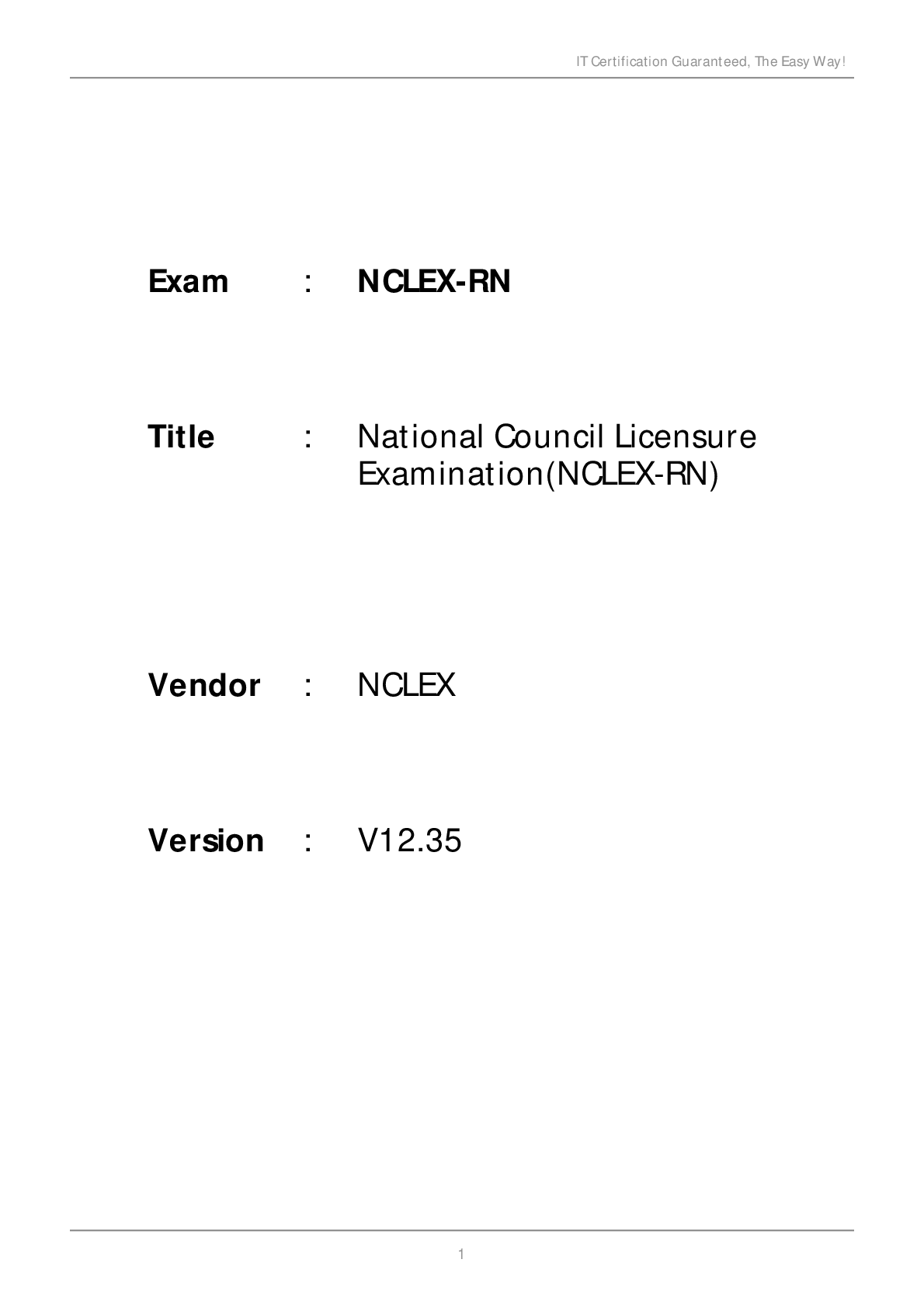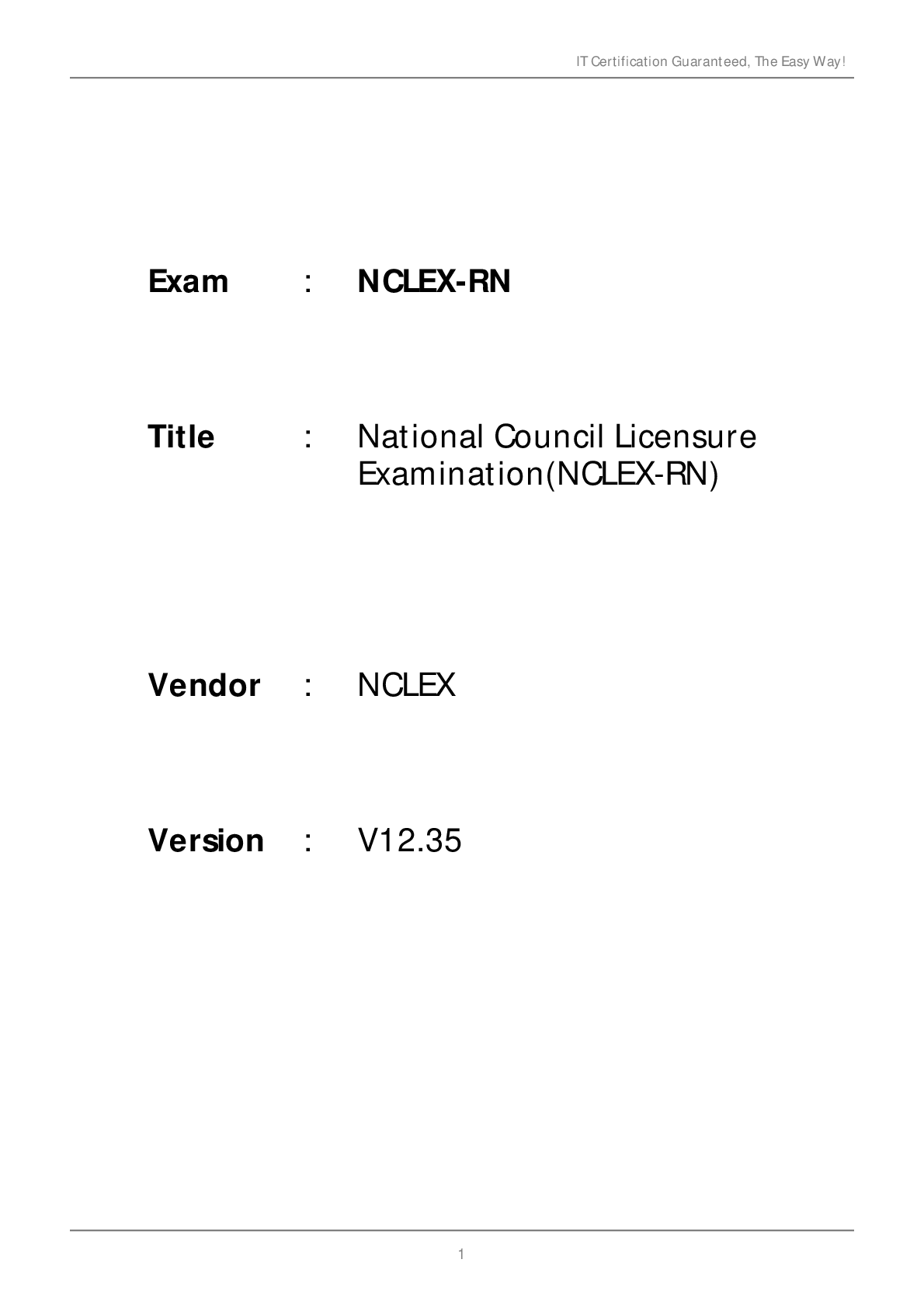NO.1 A depressed client is seen at the mental health center for follow-up after an attempted suicide
1 week ago. She has taken phenelzine sulfate (Nardil), a monoamine oxidase
(MAO) inhibitor, for 7 straight days. She states that she is not feeling any better. The nurse explains
that the drug must accumulate to an effective level before symptoms are totally relieved. Symptom
relief is expected to occur within:
A. 10 days
B. 2-4 weeks
C. 2 months
D. 3 months
Answer: B
Explanation:
(A) This answer is incorrect. It can take up to 1 month for therapeutic effect of the medication.
(B) This answer is correct. Because MAO inhibitors are slow to act, it takes 2-4 weeks before
improvement of symptoms is noted.
(C) This answer is incorrect. It can take up to 1 month for therapeutic effect of the medication.
(D) This answer is incorrect. Therapeutic effects of the medication are noted within 1 month of drug
therapy.
NO.2 Cystic fibrosis is transmitted as an autosomal recessive trait. This means that:
A. Mothers carry the gene and pass it to their sons
B. Fathers carry the gene and pass it to their daughters
C. Both parents must have the disease for a child to have the disease
D. Both parents must be carriers for a child to have the disease
Answer: D
Explanation:
(A) Cystic fibrosis is not an X-linked or sex-linked disease. (B) The only characteristic on the Y
chromosome is the trait for hairy ears. (C) Both parents do not need to have the disease but must be
carriers. (D) If a trait is recessive, two genes (one from each parent) are necessary to produce an
affected child.
NO.3 A 24-year-old client presents to the emergency department protesting "I am God." The nurse
identifies this as a:
A. Delusion
B. Illusion
C. Hallucination
D. Conversion
Answer: A
Explanation:
(A) Delusion is a false belief. (B) Illusion is the misrepresentation of a real, external sensory
experience. (C) Hallucination is a false sensory perception involving any of the senses. (D) Conversion
is the expression of intrapsychic conflict through sensory or motor manifestations.
NO.4 In acute episodes of mania, lithium is effective in 1-2 weeks, but it may take up to 4 weeks, or
2
IT Certification Guaranteed, The Easy Way!
even a few months, to treat symptoms fully. Sometimes an antipsychotic agent is prescribed during
the first few days or weeks of an acute episode to manage severe behavioral excitement and acute
psychotic symptoms. In addition to the lithium, which one of the following medications might the
physician prescribe?
A. Diazepam (Valium)
B. Haloperidol (Haldol)
C. Sertraline (Zoloft)
D. Alprazolam (Xanax)
Answer: B
Explanation:
(A) Diazepam is an antianxiety medication and is not designed to reduce psychotic symptoms. (B)
Haloperidol is an antipsychotic medication and may be used until the lithium takes effect. (C)
Sertraline is an antidepressant and is used primarily to reduce symptoms of depression. (D)
Alprazolam is an antianxiety medication and is not designed to reduce psychotic symptoms.
NO.5 A violent client remains in restraints for several hours. Which of the following interventions is
most appropriate while he is in restraints?
A. Give fluids if the client requests them.
B. Assess skin integrity and circulation of extremities before applying restraints and as they are
removed.
C. Measure vital signs at least every 4 hours.
D. Release restraints every 2 hours for client to exercise.
Answer: D
Explanation:
(A) Fluids (nourishment) should be offered at regular intervals whether the client requests (or
refuses) them or not. (B) Skin integrity and circulation of the extremities should be checked regularly
while the client is restrained, not only before restraints are applied and
after they are removed. (C) Vital signs should be checked at least every 2 hours. If the client remains
agitated in restraints, vital signs should be monitored even more closely, perhaps every 1-2 hours. (D)
Restraints should be released every 2 hours for exercise, one extremity at a time, to maintain muscle
tone, skin and joint integrity, and circulation.
NO.6 The pediatrician has diagnosed tinea capitis in an 8- year-old girl and has placed her on oral
griseofulvin. The nurse should emphasize which of these instructions to the mother and/or child?
A. Administer oral griseofulvin on an empty stomach for best results.
B. Discontinue drug therapy if food tastes funny.
C. May discontinue medication when the child experiences symptomatic relief.
D. Observe for headaches, dizziness, and anorexia.
Answer: D
Explanation:
(A) Giving the drug with or after meals may allay gastrointestinal discomfort. Giving the drug with a
fatty meal (ice cream or milk) increases absorption rate. (B) Griseofulvin may alter taste sensations
3
IT Certification Guaranteed, The Easy Way!
and thereby decrease the appetite. Monitoring of food intake is important, and inadequate nutrient
intake should be reported to the physician. (C) The child may experience symptomatic relief after 48-
96 hours of therapy. It is important to stress continuing the drug therapy to prevent relapse (usually
about 6 weeks). (D) The incidence of side effects is low; however, headaches are common. Nausea,
vomiting, diarrhea, and anorexia may occur. Dizziness, although uncommon, should be reported to
the physician.
Read More


